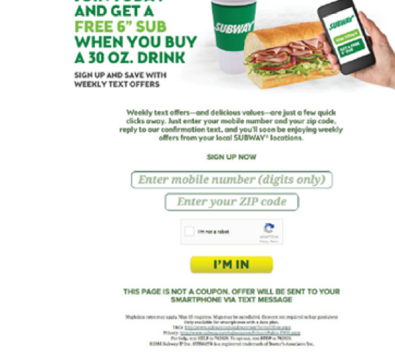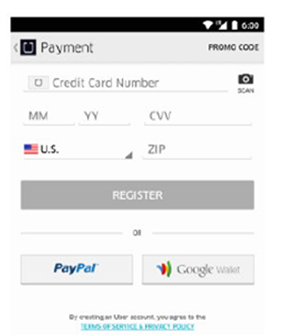Welcome back to TCPA University here at TCPAWorld.com. I’m Professor Czar. (Why not?)
Today’s lesson—how to design a process to capture reliable consent and/or binding contract terms from people perusing your website who might be interested in receiving special offers and promotions from you. And, as we shall see, this is an issue that even major corporations struggle with on their own websites.
I’ll give you the take aways up front, but I encourage you to review the rest of the lesson down below.
-
First, don’t use an undisclosed arbitration clause found only in a terms and conditions document contained in a link called “T&C’s.”
-
Second, don’t bury that T&C’s link way down at the bottom of the page far from the button a consumer clicks to purportedly accept those terms.
-
Third, definitely avoid putting a whole bunch of impertinent language in different font sizes and colors between the button and the T&C’s.
-
Fourth, make sure to include language actually and clearly explains that by clicking the button the customer will actually be accepting the T&C’s.
-
Fifth, make sure the T&C’s are apparent at the time the user clicks the submit button and don’t pop up only before or after the button is presented.
-
Sixth, try to avoid gibberish shorthand in website disclosures and via text messages that might not suffice as the sort of “clear and unmistakable” written consent required by TCPA law.
-
Seventh, and finally, remember that capturing express written consent for telemarketing is different from capturing basic assent to regular contract terms—but you’ll need to seek actual advice (and not just read a blog post) to really get my meaning on this one.
Let’s depart from the syllabus and dig into the lesson. Our study materials on this important topic come from the case of Arnaud v. Doctor’s Assocs. 18-CV-3703 (NGG) (SJB), 2019 U.S. Dist. LEXIS 153868 (E.D.N.Y. Sept. 9, 2019). There the folks behind Subway sandwiches hoped to avoid a TCPA class action by compelling arbitration of a claim brought by a consumer who had provided his phone number via an online webform submission. Unlike many cases these days in which the consumer denies encountering the webpage, the Plaintiff in Arnaud admitted that he provided his number on the website and clicked the pertinent submit button. This sounds pretty straightforward.
But there was a problem. The Plaintiff contended that he never saw the arbitration clause buried in the terms and conditions link and had no idea he was agreeing into a contract with Subway by submitting his phone number. The Court ultimately agreed with Plaintiff that no valid arbitration contract was created and, upon reviewing the layout of the website, it is easy enough to understand why.
Through the magic of modern technology I bring you an extremely fuzzy screen grab of the Subway website as it existed at the time the Plaintiff encountered it:

As you can sort of tell from the picture, below the fields for the phone number and the big “I’m in” button, the page includes large green text in all capital letters that reads: “THIS PAGE IS NOT A COUPON, OFFER WILL BE SENT TO YOUR SMARTPHONE VIA TEXT MESSAGE.” That big bold language probably serves some purpose but it certainly does not help in the creation of a contract or in the capture of consent. Notice, however, that is the most prominent “disclosure” on the page.
Below that language, in smaller print, the website stated, “Msg/data rates may apply. Max 10 msgs/mo. Msgs may be autodialed. Consent not required to buy goods/svcs Only available for smartphones with a data plan.” This language seems designed to capture express written telemarketing consent but the consent disclosure appears to omit important language and is written in bits and fragments. It is unclear to me why this language was chosen considering that this tiny disclosure could have made as long and carefully worded as the Defendant chose.
Even further down below the fuzzy consent language the website contains two links that are totally unreadable on the picture but—trust me— one is labelled “T&Cs” and the other is labelled “Privacy.” If you happened to click on the link labelled “T&Cs” you’d be taken to a document titled “TERMS AND CONDITIONS” that—way down in section 14—included an arbitration contract.
To make matters more interesting, when a person supplies a phone number and clicks “I’m in” they receive this well-worded beauty of a message:
Reply Y as ur sig 2agree 2 SUBWAY offers 2 this ph# (max 10msgs/mo-Msgs may b autodialed- Consent not req’d 2buy goods/svcs) Reply HELP=help Msg&data rates apply.
No seriously. That’s what it said.
Subway contends that Plaintiff responded “Y” to that string of gibberish for some reason and, thereby, granted express written consent to receive telemarketing messages. Plaintiff denies responding “Y” to that message because— why would anyone do such a thing?—and that even if he did that disclosure is an unenforceable Frankenstein’s monster compiled from bits and pieces of proper disclosures, and not actual English.
Ultimately the ruling in Arnaud is not about the validity of the TCPA consent purportedly obtained, however, but about the layout of the webpage through which Subway contends it obtained Plaintiff’s assent to its terms and conditions, including the arbitration clause. And the lessons the Court lays out are absolutely essential for anyone hoping to capture consent via a website to understand.
Setting the stage, here’s the law: a party is bound to a disclosure on a website if they are on inquiry notice of the term the enforcing party seeks to enforce. Translation: you don’t actually have to read a contract to be bound by its terms but you do have to be informed that you are taking actions that come with terms so that you can choose to read the terms, even though you probably won’t.
Ok, so now that we understand the law at a high level, here’s why Subway’s webpage didn’t comply with the “inquiry notice” standard.
First, the Subway webpage was cluttered. Courts are more likely to enforce clauses contained on elegant websites that contain only limited language, which clearly informs the consumer that a contract is being created by the click of a button. For instance check out this simple beauty:

On this web interface the consumer is plainly informed that by clicking the button they are agreeing to the terms and conditions and privacy policy. The words are smallish but they say: “By creating [an] account you agree to the TERMS OF SERVICE & PRIVACY POLICY.” No muss. No fuss.
Notice how the disclosure on this form is immediately below the button—this is called “spacial coupling” in the business—and how the user does not have to scroll to find the disclosures. Additionally, the disclosures are immediately present when the button appears and do not appear on a separate page or form—this is called “temporal coupling.”
But the real key is the language that plainly informs the consumer that by clicking the button they are doing something with real legal impact—they are accepting contractual terms. The consumer can choose to not read those terms–and most won’t– but a consumer encountering this website cannot reasonably claim they did not know the terms were there to begin with.
And this is true although the terms and conditions in this example are also found within a hyperlink and the hyperlink is in pretty small font— the simplicity of the page and the obviousness of the disclosure in the context of the website make it impossible for a consumer to claim they didn’t see the fine print.
The Subway page, by contrast, was much too busy. There were a bunch of extra words on the screen that did not point to the key terms and conditions to be enforced. There are distracting elements—such as photos and colors—that draw the user’s focus away from the terms and conditions at the bottom of the page. And the real key—probably the dispositive issue—was the lack of clear language explaining that by clicking the button the consumer was agreeing to the terms and conditions. As the Court put it
the page did not include language that served as ‘a clear prompt directing users to read’ the Terms of Use or that ‘signal[ed] that their acceptance of the benefit of registration would be subject to contractual terms….’ no text anywhere on the webpage indicated that the user was agreeing to any additional terms, and the fact that the link was labeled ‘T&Cs” provides little or no notice to the user that he might be bound by additional information contained at that link.
In the Court’s mind, the absence of a clear disclosure relative to the impact of clicking the button vis acceptance of the “T&C’s” sealed the deal for the Plaintiff: “Without language explicitly informing Plaintiff that clicking “I’m in” would constitute agreement to additional terms not contained on the page—and without especially clear and conspicuous display of the relevant links—merely placing the links on the same page as the action button is insufficient to provide inquiry notice.”
So there you go. Contractual terms embedded in links on websites are not likely to be enforced absent clear language notifying a customer that by clicking a submit button they are accepting those terms. This is especially true where, as in Arnaud, the terms and conditions are not “spacially coupled” with the button and other distracting elements on the website might pull the users attention away from the embedded link.
But class is not yet dismissed—there is one more issue to cover and it is a doozy. The inquiry notice rules apply to normal contract terms. The TCPA, however, requires express written consent obtained via a separately signed and conspicuous disclosure for telemarketing consent. This is an entirely separate standard and, while I won’t go further in this publicly-available record as to where I think the line is, it suffices to say that Subway is in for a real fight if it plans to enforce the consent terms on its website as binding express written consent for telemarketing purposes.
All right class, that’s it for today. Check in next time for more TCPA University.




 />i
/>i

